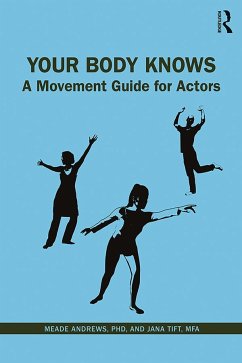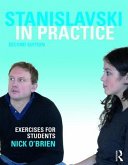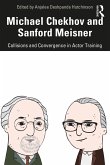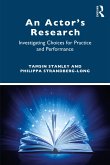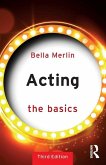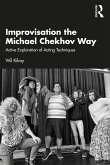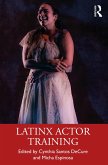- Broschiertes Buch
- Merkliste
- Auf die Merkliste
- Bewerten Bewerten
- Teilen
- Produkt teilen
- Produkterinnerung
- Produkterinnerung
Your Body Knows provides the foundation actors need to move with ease and power. It is a practical guide to movement starting at the very beginning: knowing your body and experiencing how it works.
Andere Kunden interessierten sich auch für
![Stanislavski in Practice Stanislavski in Practice]() Nick O'BrienStanislavski in Practice34,99 €
Nick O'BrienStanislavski in Practice34,99 €![Michael Chekhov and Sanford Meisner Michael Chekhov and Sanford Meisner]() Michael Chekhov and Sanford Meisner41,99 €
Michael Chekhov and Sanford Meisner41,99 €![An Actor's Research An Actor's Research]() Tamsin StanleyAn Actor's Research43,99 €
Tamsin StanleyAn Actor's Research43,99 €![Acting Acting]() Bella MerlinActing21,99 €
Bella MerlinActing21,99 €![Improvisation the Michael Chekhov Way Improvisation the Michael Chekhov Way]() Wil KilroyImprovisation the Michael Chekhov Way35,99 €
Wil KilroyImprovisation the Michael Chekhov Way35,99 €![An Actor's Research An Actor's Research]() Tamsin StanleyAn Actor's Research161,99 €
Tamsin StanleyAn Actor's Research161,99 €![Latinx Actor Training Latinx Actor Training]() Latinx Actor Training54,99 €
Latinx Actor Training54,99 €-
-
-
Your Body Knows provides the foundation actors need to move with ease and power. It is a practical guide to movement starting at the very beginning: knowing your body and experiencing how it works.
Hinweis: Dieser Artikel kann nur an eine deutsche Lieferadresse ausgeliefert werden.
Hinweis: Dieser Artikel kann nur an eine deutsche Lieferadresse ausgeliefert werden.
Produktdetails
- Produktdetails
- Verlag: Taylor & Francis Ltd
- Seitenzahl: 410
- Erscheinungstermin: 26. Februar 2020
- Englisch
- Abmessung: 247mm x 177mm x 18mm
- Gewicht: 1128g
- ISBN-13: 9780367258825
- ISBN-10: 036725882X
- Artikelnr.: 58730775
- Herstellerkennzeichnung
- Libri GmbH
- Europaallee 1
- 36244 Bad Hersfeld
- gpsr@libri.de
- Verlag: Taylor & Francis Ltd
- Seitenzahl: 410
- Erscheinungstermin: 26. Februar 2020
- Englisch
- Abmessung: 247mm x 177mm x 18mm
- Gewicht: 1128g
- ISBN-13: 9780367258825
- ISBN-10: 036725882X
- Artikelnr.: 58730775
- Herstellerkennzeichnung
- Libri GmbH
- Europaallee 1
- 36244 Bad Hersfeld
- gpsr@libri.de
Meade Andrews, PhD, is an internationally recognized, senior teacher of the Alexander Technique. She is a certified member of the American Society for the Alexander Technique (AmSat) and Alexander Technique International (ATI). She teaches Movement for Actors to students and professionals, and has served as a movement coach for over 40 theatrical productions. She is a certified teacher of the Michael Chekhov Acting Technique and has also done an extensive study of the work of Rudolf Laban and Irmgard Bartenieff with Carol Boggs, CMA. Former director of the Dance Program at American University in Washington, DC, Meade also taught at the Studio Theatre in Washington, DC for 20 years, offering classes in acting, improvisation, and Alexander Technique. With her colleague, Jeanne Feeney, she won the Helen Hayes Award for choreographing the Studio Theatre's 30th anniversary revival of HAIR. She currently teaches and coaches performers at Rider University, and the Westminster Choir College, located in Princeton, NJ. She has taught numerous workshops in the Alexander Technique for actors, dancers, singers, and musicians throughout the US, Europe, and Asia. Jana Tift, MFA, has taught movement for actors in academic and professional settings for over 20 years. Certified to teach the Alexander Technique, the Michael Chekhov Acting Technique, and Amrit Yoga, she has led workshops and coached actors and singers throughout the US and abroad. Ms. Tift taught movement in the graduate Acting program at Florida Atlantic University for ten years. She also served on the faculty at New World School of the Arts. A student of Rudolf Laban's work for many years, Ms. Tift is a founding member of the Labanites of South Florida, a collective of movement specialists dedicated to the study and promotion of Laban's work. An award-winning director, she has been a Hendrix-Murphy Foundation Artist-in-Residence at Hendrix College and an artist-in-residence at The Ragdale Foundation. She is a teaching member of Alexander Technique International (ATI) and a proud member of the Stage Directors and Choreographers Society. Ms. Tift holds an MFA in Theatre from Florida State University.
Acknowledgments
Introduction
PART I
Know Your Instrument (So You Can Really Play)
Section I The Starting Place
Chapter 1 Your Motion Detector
Chapter 2 Your 3-Dimensional Body
Chapter 3 Your Moving Breath
A Restful Break: Constructive Rest #1
Section II You Are Designed for Movement
Chapter 4 Get to Know Your Joints
Chapter 5 Joint Connections in Your Head-Spine-Pelvis
Chapter 6 Joint Connections in Your Arm Structure
Chapter 7 Joint Connections in your Feet, Legs, and Pelvis
Chapter 8 Strong Bones, Dynamic Muscles
Chapter 9 Connecting Your Joints and Your Whole Body
A Restful Break: Constructive Rest #2
Section III What You Think Is What You Get
Chapter 10 Your Body-Mind Connection
Chapter 11 Body Myths vs. Anatomical Facts
Chapter 12 Your Primary Coordination
Section IV Claiming Your Inner and Outer Space
Chapter 13 Your Inner Space
Chapter 14 Exploring "Outer Space"
Chapter 15 Inner and Outer Space: A Movement Partnership
Section V Pathway to Presence: Putting It All Together
Chapter 16 Connecting Body, Mind, Breath, and Space
Chapter 17 Practicing Presence
PART II
Elements of Expression
Section VI Authenticity and Commitment
Chapter 18 Authentic Impulse: Listening Within
Chapter 19 Your Body Leads The Way
Chapter 20 The Four Brothers
Section VII Foundations
Chapter 21 Space
Chapter 22 Time
Chapter 23 Weight
Chapter 24 Flow
Chapter 26 Qualities of Movement
Chapter 27 Shape
Chapter 28 Spatial Tools
Chapter 29 Text and Your Responsive Body-Mind
PART III
Creative Practice
Chapter 30 Whole-body Warm-up: Staccato-Legato
Chapter 31 Movement, Character, and Relationships: Putting Principles and
Skills Into Practice!
Chapter 32 Performing for an Audience: My Space, Your Space, Their Space
Chapter 33 Movement and Space: Creating the World of the Play
Conclusion
List of Key Words and Key Practices
Appendix I - Practices for Further Exploration
Appendix II - The Movement Pioneers
Bibliography
Index
Introduction
PART I
Know Your Instrument (So You Can Really Play)
Section I The Starting Place
Chapter 1 Your Motion Detector
Chapter 2 Your 3-Dimensional Body
Chapter 3 Your Moving Breath
A Restful Break: Constructive Rest #1
Section II You Are Designed for Movement
Chapter 4 Get to Know Your Joints
Chapter 5 Joint Connections in Your Head-Spine-Pelvis
Chapter 6 Joint Connections in Your Arm Structure
Chapter 7 Joint Connections in your Feet, Legs, and Pelvis
Chapter 8 Strong Bones, Dynamic Muscles
Chapter 9 Connecting Your Joints and Your Whole Body
A Restful Break: Constructive Rest #2
Section III What You Think Is What You Get
Chapter 10 Your Body-Mind Connection
Chapter 11 Body Myths vs. Anatomical Facts
Chapter 12 Your Primary Coordination
Section IV Claiming Your Inner and Outer Space
Chapter 13 Your Inner Space
Chapter 14 Exploring "Outer Space"
Chapter 15 Inner and Outer Space: A Movement Partnership
Section V Pathway to Presence: Putting It All Together
Chapter 16 Connecting Body, Mind, Breath, and Space
Chapter 17 Practicing Presence
PART II
Elements of Expression
Section VI Authenticity and Commitment
Chapter 18 Authentic Impulse: Listening Within
Chapter 19 Your Body Leads The Way
Chapter 20 The Four Brothers
Section VII Foundations
Chapter 21 Space
Chapter 22 Time
Chapter 23 Weight
Chapter 24 Flow
Chapter 26 Qualities of Movement
Chapter 27 Shape
Chapter 28 Spatial Tools
Chapter 29 Text and Your Responsive Body-Mind
PART III
Creative Practice
Chapter 30 Whole-body Warm-up: Staccato-Legato
Chapter 31 Movement, Character, and Relationships: Putting Principles and
Skills Into Practice!
Chapter 32 Performing for an Audience: My Space, Your Space, Their Space
Chapter 33 Movement and Space: Creating the World of the Play
Conclusion
List of Key Words and Key Practices
Appendix I - Practices for Further Exploration
Appendix II - The Movement Pioneers
Bibliography
Index
Acknowledgments
Introduction
PART I
Know Your Instrument (So You Can Really Play)
Section I The Starting Place
Chapter 1 Your Motion Detector
Chapter 2 Your 3-Dimensional Body
Chapter 3 Your Moving Breath
A Restful Break: Constructive Rest #1
Section II You Are Designed for Movement
Chapter 4 Get to Know Your Joints
Chapter 5 Joint Connections in Your Head-Spine-Pelvis
Chapter 6 Joint Connections in Your Arm Structure
Chapter 7 Joint Connections in your Feet, Legs, and Pelvis
Chapter 8 Strong Bones, Dynamic Muscles
Chapter 9 Connecting Your Joints and Your Whole Body
A Restful Break: Constructive Rest #2
Section III What You Think Is What You Get
Chapter 10 Your Body-Mind Connection
Chapter 11 Body Myths vs. Anatomical Facts
Chapter 12 Your Primary Coordination
Section IV Claiming Your Inner and Outer Space
Chapter 13 Your Inner Space
Chapter 14 Exploring "Outer Space"
Chapter 15 Inner and Outer Space: A Movement Partnership
Section V Pathway to Presence: Putting It All Together
Chapter 16 Connecting Body, Mind, Breath, and Space
Chapter 17 Practicing Presence
PART II
Elements of Expression
Section VI Authenticity and Commitment
Chapter 18 Authentic Impulse: Listening Within
Chapter 19 Your Body Leads The Way
Chapter 20 The Four Brothers
Section VII Foundations
Chapter 21 Space
Chapter 22 Time
Chapter 23 Weight
Chapter 24 Flow
Chapter 26 Qualities of Movement
Chapter 27 Shape
Chapter 28 Spatial Tools
Chapter 29 Text and Your Responsive Body-Mind
PART III
Creative Practice
Chapter 30 Whole-body Warm-up: Staccato-Legato
Chapter 31 Movement, Character, and Relationships: Putting Principles and
Skills Into Practice!
Chapter 32 Performing for an Audience: My Space, Your Space, Their Space
Chapter 33 Movement and Space: Creating the World of the Play
Conclusion
List of Key Words and Key Practices
Appendix I - Practices for Further Exploration
Appendix II - The Movement Pioneers
Bibliography
Index
Introduction
PART I
Know Your Instrument (So You Can Really Play)
Section I The Starting Place
Chapter 1 Your Motion Detector
Chapter 2 Your 3-Dimensional Body
Chapter 3 Your Moving Breath
A Restful Break: Constructive Rest #1
Section II You Are Designed for Movement
Chapter 4 Get to Know Your Joints
Chapter 5 Joint Connections in Your Head-Spine-Pelvis
Chapter 6 Joint Connections in Your Arm Structure
Chapter 7 Joint Connections in your Feet, Legs, and Pelvis
Chapter 8 Strong Bones, Dynamic Muscles
Chapter 9 Connecting Your Joints and Your Whole Body
A Restful Break: Constructive Rest #2
Section III What You Think Is What You Get
Chapter 10 Your Body-Mind Connection
Chapter 11 Body Myths vs. Anatomical Facts
Chapter 12 Your Primary Coordination
Section IV Claiming Your Inner and Outer Space
Chapter 13 Your Inner Space
Chapter 14 Exploring "Outer Space"
Chapter 15 Inner and Outer Space: A Movement Partnership
Section V Pathway to Presence: Putting It All Together
Chapter 16 Connecting Body, Mind, Breath, and Space
Chapter 17 Practicing Presence
PART II
Elements of Expression
Section VI Authenticity and Commitment
Chapter 18 Authentic Impulse: Listening Within
Chapter 19 Your Body Leads The Way
Chapter 20 The Four Brothers
Section VII Foundations
Chapter 21 Space
Chapter 22 Time
Chapter 23 Weight
Chapter 24 Flow
Chapter 26 Qualities of Movement
Chapter 27 Shape
Chapter 28 Spatial Tools
Chapter 29 Text and Your Responsive Body-Mind
PART III
Creative Practice
Chapter 30 Whole-body Warm-up: Staccato-Legato
Chapter 31 Movement, Character, and Relationships: Putting Principles and
Skills Into Practice!
Chapter 32 Performing for an Audience: My Space, Your Space, Their Space
Chapter 33 Movement and Space: Creating the World of the Play
Conclusion
List of Key Words and Key Practices
Appendix I - Practices for Further Exploration
Appendix II - The Movement Pioneers
Bibliography
Index

